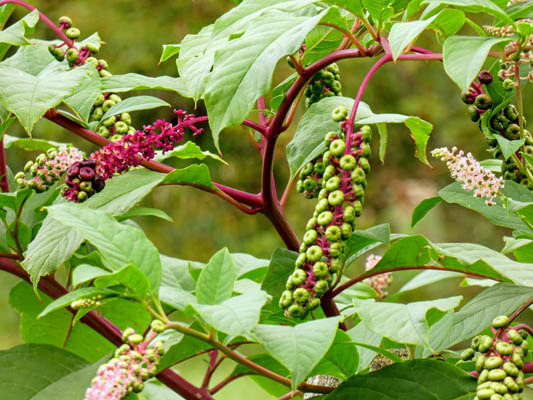So, You Think You Love Horses?
Some Reflections on the Nature of Horses and Man
Glossary of Equestrian Terms
Words Beginning with P
-
Pace
[Equine Gaits] A pace is a unique two-beat gait that only some horses use and in which the two legs on the same side of the horse move forward together, unlike the trot, where the two legs diagonally opposite legs move forward together. Horses who naturally trot are much more common than those who naturally pace. A fast pace is uncomfortable for riding and very difficult to sit to. A slow pace, is better tolerated. Many harness horses pace and look really flashy doing it.
-
Paddock
[Equine Management] A paddock is a small fenced enclosure for horses, often adjacent to the stable. Large enclosures are called fields. Paddocks serve the purpose of keeping horses in an area where they can be reached with greater easy. I limit mine to the paddock area when I plan to ride or have the vet or farrier coming. They would rather be in the paddock than closed in their stalls.
-
Paddock Boots (Jodhpur Boots)
[Equestrian Equipage] Paddock boots are a type of short riding boots that come just above the ankle. They are often paired with half chaps. That particular combination works together to simulate taller riding boots. The rules of various shows often govern whether or not riders of certain ages may wear paddock boots in the show ring.
-
Palfrey
[Equine Type] The term palfrey was applied to a medieval horse type that was used as a general riding horse and not used as a war horse. They processed a a smooth, ambling middle gait. Over time the meaning evolved to imply a suitable mount for a lady.
-
Palomino
[Horse Coat Color Breed] Palominos have gold coat and light colored mane and tail, generally white. Their coloration makes them stand out and they are popular in the show ring and in various motion pictures.
-
Panic Quick Release Snap
Panic Snaps in open and closed position
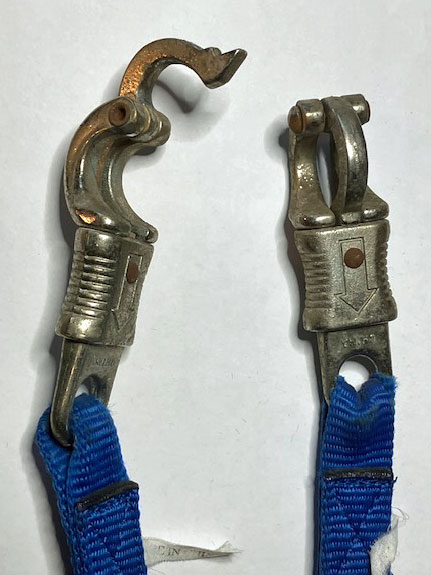
|
[Horse Equipment] A panic snap is a type of metal quick release snap commonly used on trailer or cross ties that can be quickly released even when the horse is forcefully pulling against the tie. I would rather have a horse tied with a panic snap than a quick release knot, which tends to tighten if a horse is pulling against it.
-
Para-Equestrian
[Equestrian Sports] Para-equestrians are riders or drivers with recognized physical handicaps who compete in two recognized and governed sports: para-equestrian dressage para-equestrian driving. Rules are modified to account for individuals disabilities. I recall watching Bettina Eistel, a double arm amputee dressage rider, who competed in the 2008 Paralympic Games in Beijing.
-
Park Out
[Equine Posture] A horse that is parked out stands with its rear legs extended and head held high. This posture is used in horse shows to display conformation and also in carriage horses who were taught to park out when they are, no surprise, parked. There was a sense that in this posture they were unlikely to shift when passengers were entering or leaving the carriage.
-
Parrot Mouth (Overshot Jaw or Overjet)
[Veterinary Medicine] A horse with an overshot jaw has a lower jaw shorter than the upper one, causing a malocclusion of the teeth. The nipping teeth (incisors), but not the cheek teeth (molars) are affected. The condition appears genetic and becomes noticeable as a young horse's jaw develops. It presents problems nipping glass and results in poor nutrition. There are treatments available if the condition is recognized early.
-
Part Board (Part Lease)
[Equine Management] A part board situation is an agreement between two individuals to share the riding time of a single horse and often expenses as well.
-
Parthian Shot
An Ancient Depiction of a Parthian Shot
Courtesy of Wikipedia

|
[Military] A Parthian shot is performed by a mounted archer, who twists facing backwards in the saddle and fires an arrow at a pursuing enemy. It is named after a tribal people that were well-practiced in using the strategy.
Pas de Deux (French Step of Two
[Dressage] In a pas de deux two dressage riders perform a mirror images of each other's movements and transitions. Music, otherwise optional, is mandatory for competitive pas de deux.
-
Paso Corto (Spanish for Short Step)
[Equine Gait] The Paso Corto is an ambling gait of a Paso Fino that is faster than a walk.
-
Paso Fino
[Horse Breed] Paso Finos are relatively small naturally gaited, riding horses originally bred in Puerto Rico and also Columbia. Their unique four-beat lateral gait is innate and can be quickened or slowed and produces a comfortable ride in which the rider is fairly stationary but the horse's legs seem to be working furiously. The horse is also capable of the common gaits of walk, lope or canter,
-
Paso Largo (Spanish for Long Step)
[Equine Gait] The Paso Largo is the fastest gait of a Paso Fino that is faster than a walk and similar to the rack of other breeds of gaited horses.
-
Paso Llano (Spanish for Even Step)
[Equine Gait] The Paso Llano is an ambling four-beat gait Peruvian Paso that is similar in speed to a trot.
-
Passage
[Dressage] The passage is a collected, highly elevated and powerful trot. There is a prolonged period of suspension, causing it to be very eye catching.
-
Pastern
[Equine Anatomy] The pastern is the part of the horse's lower leg between the fetlock and the top of the hoof. Within the pastern are two bones: the long pastern and the short pastern.
-
Pecking Order
[Equine Behavior] It is the natural behavior of a herd of horses to establish a pecking order. At the top is an alpha or dominant horse and the others each have their rank order. As an owner you may not like the behaviors that this generates, but you really cannot influence it and need to accommodate to this inherent behavior. For example, close the horses in their individual stalls while eating and place multiple flakes of hay to avoid the alpha from chasing the others away from their intended feed. It is surprising how this can turn out. A very small, innocent appearing pony terrified my wife's large Thoroughbred. That was almost ludicrous, but that was how it has.
-
Pelleted Horse Feed
Pelleted Horse Feed

|
[Horse Nutrition] Pelleted horse feed is a uniform pellet product that is similar in nutritional value and admixed ingredients to the more traditional textured sweet feed. I find the pellets are easier to handle and do not leave a residue on feed buckles or other containers. Certain horses may prefer one or the other and occasional horse will eat pellets too quickly. Dietary starch is higher in textured feed and might be an issue in horses with metabolic issues. Pellets can be stored longer.
-
Pelham Bit
Pelham Bit with a Solid Mouthpiece and No Port
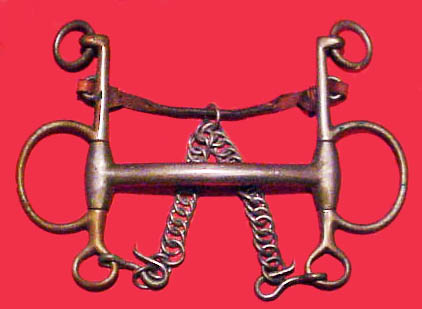
|
[Equine Equipage] Pelham bits are basically leveraged bits but some have elements of both a curb and a snaffle bit designs. These normally have double reins, serving the curb and snaffle elements and by necessity separate rings for the reins. You can recognize a Pelham by the presence of the curb chain and multiple rings. The month piece is variable in both design and function and may be solid (curb only) or jointed (curb and snaffle). Certain Pelham designs feature a port on the month piece and others do not. Interestingly, Pelhams are not permitted in dressage competition or western riding disciplines. I have no experience using one.
-
Pelham Bit Converter
[Equine Equipage] A Pelham bit converter is a rig consisting of two straps that interconnect the curb and snaffle bits in a way that only one rein is necessary to use rather then two.
-
Pentathlon
[Equine Competition] A pentathlon is five-phase Olympic event in which the competitor must run a cross county course on foot, jump a course on horseback, fence against another competitor, target shoot with an air pistol and freestyle swim. The modern event dates from 1912 and harkens back to a time that military officers often represented their nations and this group of skills were needed by military couriers. Since 2000 there have been separate male and female competitions. There also is another track and field event called a pentathlon that does not involve any riding.
-
Percheron
[Horse Breed] Percherons are a breed of draft horse that originated in the Huisne river valley in western France. They are generally gray or black in color, They are large animals with maximum weights as much as 2,600 pounds and height at the withers of 19 hands. Although predominately a draft horse, some are ridden astride. They are imposing in their size but are known for their evenness of temper.
-
Periodic Ophthalmia (Moon Blindness or Recurrent Iridocyclitis)
[Veterinary Medicine] Periodic ophthalmia is serious, recurring inflammatory of the eyes that can result in total loss of sight over time. Signs of inflammation appears in either one or both eyes suddenly and then remit in a few days. The horse is sensitive to light, has a closed eye lids, constricted pupils, conjunctivitis and lacrimation. Riboflavin may have preventative value, but is not helpful in treatment. Certain species of bacteria may also play a role and can be treated with antibiotics. Autoimmune etiologies are suspect and can be treated by steroids. I should point out that this condition may represent several different diseases with different causes, all presenting with the identical symptoms of periodic ophthalmia. In addition, there are several common and less serious conditions that present with some of the symptoms of periodic ophthalmia. There is no substitution for a prompt veterinary consultation if this condition is suspect.
-
Perissodactyla
[Equine Taxonomy] Perissodactyla is the taxonomic order name in the classification of animals including horses, tapiers and rhinoceroses. Members of the order have an odd number of toes on at least two of the hooves on which they walk.
-
Peruvian Paso
[Horse Breed] Peruvian Pasos are a bred of naturally gaited, riding horses originally bred in Peru. They have unique four-beat lateral gait that is innate and are also capable of the common gaits of walk or canter but do not trot, They are larger and wider than the typical Paso Fino to which they are often compared.
-
Phaeton
[Carriage Type] A Phaeton is a type of a light, open, four-wheeled carriage, drawn by either one or two horses, with front and back seats and often a folding top for the front. There are a number of subcategories of phaetons.
-
Phenylbutazone (nicknamed Bute)
[Veterinary Medicine] A nonsteroidal anti-inflammatory drug, commonly used in situations like lameness or other injuries. It can have side effect, such as causing peptic ulcers and should be used judiciously.
-
Physical Ride
[Ride Descriptor] This term is commonly bantered about, but as far as I can find no one has tried to expressly define it. I suppose that when you get off your horse and say, "Wow, that was a physical ride," then you have had one. What it describes is a ride that was great exercise for man and beast and a satisfactory performance by the horse, successfully meeting such challenges as might have occurred. In short, it was a positive experience that was both exhilarating and challenging to the rider. However, the last thing a novice rider wants is a physical ride.
-
Pica (Depraved Appetite)
[Equine Behavioral Vice] A horse exhibits a pica when it eats substances that are not typical food and have no nutritional value. Dirt, wood, bark, hair, and even feces are typical. Coprophagy (eating feces) is felt to be normal in young horses and may be needed to populate the important gut flora need for proper digestion. In adult horses pica may be the result of boredom. Scientific research into the question of pica resulting from nutritional deficiencies have generally failed to establish a correlation. In some horses pica can lead to the formation of bezoars in the gastrointestinal track.
-
Pick
[Horse Management] Cleaning the bottom of a horse's hoof is called picking. The first step is to shift the horse's weight off of the foot to be cleaned and then bending the horse's leg so as to expose the bottom of the hoof. The rider should be alert to the possibility that the horse might try to move during the process and let go to avoid being injured if need be. Using a specialized tool called a hoof pick, foreign material is carefully removed from the bottom of the hoof, including more gently around the sides of the frog. Most experienced horses are cooperative with the process. Needless to say, there are various tricks involved in doing this and if you are doing it for the first time get instruction. (The term is also used for removing horse manure from an area.)
-
Picket Pin
[Equine Equipage] A picket pin is a heavy metal stake with a rotating ring set in the top. Once driven into the ground like a tent stake, a horse can be tied to it. I tried it once and my horse pulled it loose. It is suggested not use less than the 30 feet rope and to attach to a single hobble rather than a halter.
-
Pick Up Man
[Rodeo] A pick up man is a skilled mounted rider who works at a rodeo in the rough stock competitions of bareback riding, saddle bronc riding, and bull riding. His responsibilities are centered around the competitor's safety. He assists the rider in dismounting by riding alongside and pull the competitor over to his mount or will herd or rope an unruly animal and removed it from the area.
-
Piebald
[Horse Color Pattern] Piebald coloration is a term applied to many different animals and means mixed black and white patches of fur. When applied to horses the term is mostly used in the United Kingdom now, while in the U.S. this pattern is commonly called a black and white pinto. The British in contradistinction use the term skewbald for those horses that have white with areas of color other than black, while in the U.S. we might say a bay pinto for example.
-
Pink Ribbon
Fifth Place Winner Ribbon
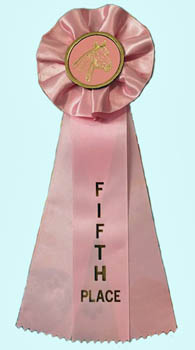
|
[Show Showing] In the United States a pink ribbon is awarded to 5th place winners.
-
Pinto (Coloured: British English terminology)
[Horse Color Pattern] A horse with pinto coloration has large patches of white mixed with patches of some other coat color. The tern pinto does not apply to any given breed of horse. However, pinto coloration is characteristic of the American Paint Breed. Pinto horses are depicted in ancient artworks and have been known for millennia.
-
Pinworms (Oxyuris equi)
[Veterinary Medicine] Pinworms are a small, white parasites that live in the intestines and anal regions of a horse. The infested horse often rubs its tail against solid objects. There are eggs that the pinworm lays in the anus that cause itching and the surfaces that horse is rubbing on becomes a source of infection for other animals. It is common that usual fecal analysis misses pinworms and their eggs. A piece of scotch tape touched multiple times to a horse's anus will pick up pin worm eggs, which can be seen under a microscope. There are anthelmintics that kill pinworms. Pinworms exist in humans, but it is a different species and a human will not get horse pinworms.
-
Pirouette
[Dressage] When a horse does a pirouette the horse's forequarters circle around the hindquarters in a walk or in a canter.
Placebo Response in Horses
[Veterinary Medicine] One might think that higher order intellectual capabilities are required for a placebo response but their is a large body of scientific literature demonstrating the existence of placebo responses in animals. Horses are very intuitive animals and it is also likely that their caregiver's response to the administration of the placebo is picked up and influences the animals response. There are studies that purport to show that horses are superior to dogs in reading human emotional responses. They may be less demonstrative in response to what they read causing us to miss the fact. I am not aware if any studies of placebo responses have looked at the role of the human caregiver.
-
Plate (Racing Plate)
Racing Plate

|
[Equine Equipage] A racing plate is a special light-weight, aluminum horse shoe intended for racing.
-
Play Day (Gymkhana Horse Games)
Play Day Blue Ribbon

|
[Youth Competition] Play days are competitive, generally team games, for young riders, with goals of having fun, practicing mounted skills, good sportsmanship and introducing young riders to mounted competition. These events are mostly seen with western riding, but have also been adapted for young English riders. There is always room for creativity in designing a particular game, but common ones include: barrel racing, pole bending, arena racing, flag racing, egg in spoon racing, costume contests, musical tubes (like musical chairs, but placing a boot in a tube rather than sitting) and many others.
-
Pleasure Riding
[Equestrian Activity] . A pleasure ride is a recreational ride that in most cases is distinct from forms of competitive riding. However, there are competitive events based on a pleasure riding format. The term hack is commonly used in the United Kingdom and occasionally in areas of the U.S. In the United States most riders use the term trail riding. I suspect that even the most dedicated rider, focused on various competitive sport riding, will occasional allow themselves a nice pleasure ride. If we did not find pleasure in riding, why do we even bother?
-
Points of Teeth
[Equine Dentistry] The points of a horse's teeth are the sharp points that develop on the edge of cheek teeth and must be filed away by a process known as floating. If floating is not done the points can interfere with proper grazing.
-
Point-to-Point Race
[Horse Race] A point-to-point race is race performed over a course of jumping obstacles, similar to those encountered while fox chasing. This race differs from steeplechases or timber races in that there is no prize money and these riders are adult amateurs and must be a members of the sponsoring hunt club with horses that are experienced hunters.
-
Pokeweed (Phytolacca americana)
[Toxic Plant to Horses] Pokeweed is a poisonous, herbaceous perennial plant. Its toxic compound is phytolaccotoxin, which causes a burning sensation in the mouth, colic, and diarrhea. Fortunately pokeweed is not very palatable and horses mostly avoid it.
-
Poling
Form of Poling Practiced in 1902
The author wrote disapproving of it.
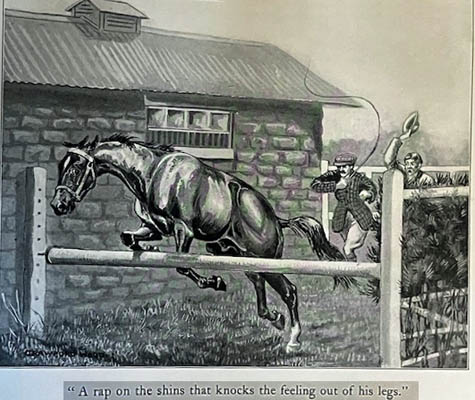
|
[Jumper Training Practice] Poling is a controversial practice of deliberating hitting a horse's front legs as a measure of getting him to keep the legs up while going over a jump. Many people view this as being a form of animal cruelty, but it has been done for a very long time. Those who defend the practice claim only a light touch is needed and that it is effective. The trend seems to be moving toward the sense that it should not be done.
-
Poll
[Equine Anatomy] The poll is the protrusion of the occipital bone at the back of the skull and the highest point of a horse's head between the ears.
-
Poll Run (Poll Bending)
Poll Bending as Part of a Play Day
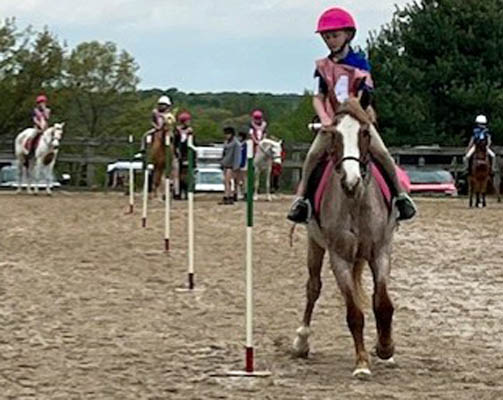
|
[Equestrian Competition] A pole run is a timed event in which a horse and rider, often as a member of a team, weave through a series of poles as quickly as possible without knocking any down. It is a feature of rodeos, play day gymkhanas, and other 4-H events.
-
Poll Evil
[Veterinary Medicine] Inflammation in the region of the pole, often result of bruising
-
Polo
U.S. Stamp featuring Polo

|
[Equestrian Sport] Polo is a mounted field sport now played by two teams of four horsemen each. The game consists of six periods lasting seven to seven and one-half minutes each, called chukkers. The teams play on a field measuring 160 by 300 yards and teams score by driving a ball though an eight-yard-wide goal.
-
Polo Ball
[Polo] A Polo ball is made of white plastic. It weighs four and one-half ounces and has a diameter of three and one-half inches. The word polo comes from the Tibetan word pulu, which means ball and polo is considered the world's oldest of ball games.
-
Polo Penalties and Fouls
Polo Fouls
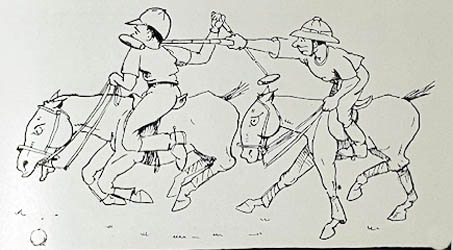
|
[Polo] Polo has an extensive list of rules with various penalties for breaking them. They are way too complex to summarize in this glossary. Their propose is mainly safety and fair play. Rules are enforced by a referee.
-
Polocrosse
[Equestrian Sport] Polocrosse is a mounted field sport incorporating elements of the Native American game of Lacrosse and the Central Asian sport of Polo. It is played by two teams of fielding 3 horsemen at a time of the total of 6 players on the team. The game consists of six to eight periods, lasting six minutes in usual games, also called chukkers after polo. The teams play on a field measuring 160 by 60 yards and smaller than a regulation polo field, Rather than a polo mallet they use a stick with a net attached.
-
Pony
Child on a Pony

|
[Equine Type] Technically a pony is a small horse that might be a member of a specific smaller breed or a mix and whose height at the withers is below 14 hands 2 inches (58 inches). In practice the term may be used in context loosely applying to any horse, regardless of height. For example, Lead ponies, cow ponies, polo ponies are almost always technically horses. Ponies most often are used as children's mounts.
-
Pony Club
[Riding Organization] The United States Pony Clubs, Inc. established in 1929 to teach riding and the proper care of horses, originally to America's youth, but now available to all ages. Its mission's major goals are to promote sportsmanship, stewardship and leadership through horsemanship. Many current riders can testify to the value of their introduction to horsemanship via their participation in local Pony Cub chapters.
-
Pony Club
[Riding Organization] The United States Pony Clubs, Inc. established in 1929 to teach riding and the proper care of horses, originally to America's youth, but now available to all ages. Its mission's major goals are to promote sportsmanship, stewardship and leadership through horsemanship. Many current riders can testify to the value of their introduction to horsemanship via their participation in local Pony Cub chapters.
-
Pony Goal
[Polo] A Pony goal occurs when a polo pony happens to knock the ball between the goalpost.
-
Ponying
[General Term] Ponying is a term for leading one horse, mounted or unmounted, with another horse generally by means of a line attached to its head. This is done as a means of exercising two horses, moving a horse to a different location, controlling the mount of an inexperienced rider,calming and directing a race horse before and after a race and for many additional reasons. Caution must be exercised when ponying since controlling one horse under all circumstances can be difficult enough and controlling two horses is a multiplier. In most cases the "lead pony" is actually a horse. It is helpful to have horses already known to each other or one experienced in being ponied.
-
Pony Jock
[Polo] A pony jock is a short-statured, light weight rider hired to ride a show pony in a horse show.
-
Pony of the Americas
[Horse Breed] The Pony of the Americas is a breed developed in the state of Iowa. The foundation stallion was a cross-bred horse with Arabian, Appaloosa and Shetland blood lines. Although these horses are pony sized, their characteristics are more typical of a small horse. They are required to have Appaloosa markings visible from 40 feet. Ponies of this type are considered ideal as a young persons mount and original showing rules, now expanded) had restricted them to younger riders.
-
Pony Trekking (British Usage)
[Equine Touring] Pony trekking is a escorted trail ride that is part of a vacation tour. You may be lucky and draw a full-sized horse, but in our case we got a pony whose head was nearly the size of its body. I have never encountered this term used in the United States.
-
Port of a Bit
Mouthpiece of a Civil War Bit
showing port and bars of bit

|
[Equine Equipage] A port is an arch shaped curved extension located in the center of the mouthpiece of curb bits. The major function of the port is to allow room for the horse's tongue. An additional function in those ports that are high is when the reins are pulled the port rotates up and against the roof of the horse's month. Certain bit types, for example the Pelham feature versions with and without ports.
-
Post Chaise
[Driving] A post chaise is type large, four-wheeled, closed coach for passengers and mail.
-
Posting
A Young Rider Posting
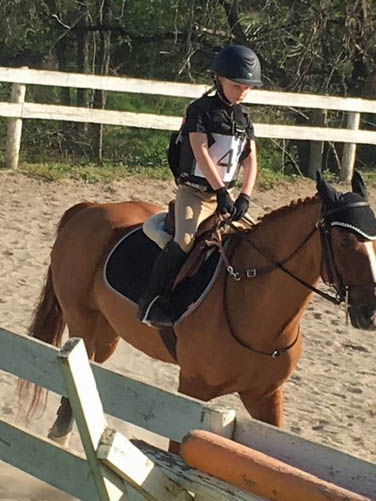
|
[Riding technique] Posting describes a rider rhythmically rising and sitting while a horse is trotting. It allows for a comfortable ride at a trot rather than that sensation of being bounced all around. The real skill that needs to be developed is to follow the impulsion of the horse and thus the movements are fairly passive. You passively rise in the stirrups and then allow yourself to drop back down into the saddle on the proper beat of the horse's hooves. The technique is relatively modern and was developed by the outriders on British mail coaches, hence the name post. Posting caused a revolution in riding and for the first time horses processing a natural trotting gait were viewed as desirable. Just like there is a correct lead in cantering there is something called a correct diagonal (a set of diagonal legs moving forward at the time the others are trailing behind) when posting to a trot in a riding ring or moving in a circle. There are still diagonals when going straight but a given one is not correct or incorrect at the time. You are supposed to "rise and (then) fall to the (horse's) leg by the wall." Fall to the leg by the wall means the rider sits when the outside hind leg is on the ground. I found it very hard to initially learn how to post. Because of some quirk in the wiring of my brain, right and left are still rather abstract concepts to me and figuring out my diagonal seemed nearly impossible. It is hard to simultaneously study the horse's footfalls and watch where I was going. I must confess I have long since stopped worrying which diagonal I am on and just hope I am instinctively doing it correctly. When I ride I mostly am either walking or cantering anyhow. I will trot when I need to catch up with another rider ahead of me or am part of a group that are all trotting. This confession with horrify proper horse people but I am an accidental horseman after all.
-
Posting Trot (Rising Trot)
[Basic Riding] A posting trot is simply one in which the rider is posting. It is not so easy to learn, but may not be so hard if you have a sense of rhythm, unlike myself. The other type of trot, done less frequently, is a sitting trot, in which the rider remains seated. That is not so easy either, but surprisingly can be mastered, particularly if the horse is doing a slow trot. I always surprise myself when I am enjoying a nice long sitting trot.
-
Postilion (Postillion)
[Coaching] A postilion is a person who rides a harnessed horse that is pulling a horse-drawn vehicle such as a coach. Large state coaches or artillery limbers and artillery caissons were not turned by a seated driver, but steered by men mounted on the each of the left animals of per pair of horses in the traces.
-
Post Parade
[Racing] The post parade is a pre-race procession of the race horses that allows spectators to view the entries.
-
Post Parturition Guidelines
The basic post parturition guideline can be remembered as the 1-2-3 rule. The foal should stand within one hour of delivery, nurse within two hours, and the placenta should pass within three hours.
-
Potomac Horse Fever (PHF)
May Fly (Courtesy: National Wildlife Federation)
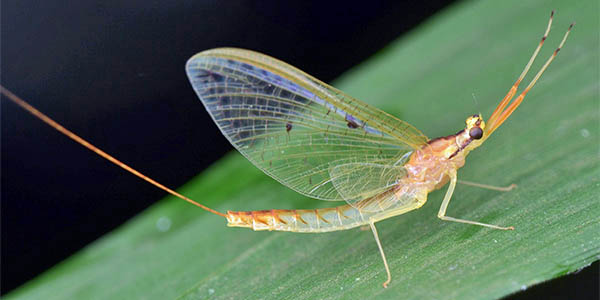
|
[Veterinary Medicine] Potomac horse fever is an infectious diseased caused by the intracellular Rickettsial bacterium Neorickettsia risticii. It is not spread directly from horse to horse, but seems to result from the accidental ingestion of infected mayflies, known to appear in swarms around stables, The symptoms include high fever, diarrhea, laminitis, loss of appetite, lethargy, mild colic-like symptoms. A vaccine is available, but not always effective and tetracycline family antibiotics will kill the organism. PHF can be fatal and be sure to remove insects floating in your stock tanks. I keep a net by the tank and do not have a light source near it.
-
Psychics
[Equine Professional] There is a group of horse people who strongly believe that there are those individuals who are capable of psychic interaction with specific horses. I have heard testimonials about psychics learning of issues the horses were having being corrected and then behavioral problems resolving, etc. I am a skeptical person and find psychics vague in their predictions and dependent on the subject latching onto something said and fitting it into a life event. For example psychic Jeane Dixon was always saying that she saw a dark cloud over the White House. Considering the history of the 20th century that is about the safest bet you can make. Anyhow, we all can decide our own believes. The book "A Year at the Races" bu Jane Smiley, who is a believer, includes stories of her interesting experiences with psychics.
-
Prepotency
[Horse Breeding] Prepotency is the ability of a stallion to pass specific traits to its offspring.
-
Pre-Purchase Veterinarian Exam (Vetting)
[Horse Management] A pre-purchase veterinarian exam is often a contingency when a horse is purchased, particularly the more expensive ones. The purpose is to establish that the horse is sound and healthy.
-
Pricked Ears
[Horse Posture] When a horse is standing erect with the ears tall and facing forward it is said the have its ears pricked. It is a sign of alertness. He is focused on something that is not ordinary and is deciding what significance it might have. If you are on his back at the time, you should also evaluate the situation and reassume him if called for.
-
Primitive Markings
[Horse Coat Marking] The term primitive markings applies to certain coat markings retained in some breeds of horses, as well as Przewalski's horses, zebras and other equines. Primitive markings were characteristic of those horses originally domesticated by man, but with selected breeding have disappeared from most modern horse breeds. Horses with a dun coat exhibit primitive markings. The dorsal stripe is the most noticeable of the primitive markings. Other markings include leg bars (horizonal stripes of coloration on the legs), various head markings and guard hairs on the main and tail. Interestingly, some foals of other breeding are born with primitive markings that they loose as they grow older.
-
Prix Caprilli (French Caprilli Prize)
[Dressage] A Prix Caprilli dressage test is a combination of jumping and dressage performed in the same ring. The test can be divided into classes based on difficulty. The name is taken from Italian Cavalry Captain Federico Caprilli (1868-1907), who popularized a forward seat jumping style in equestrian competition.
-
Prix St. Georges (French St. Georges Prize)
[Dressage] A Prix St. Georges dressage test is a higher level test that is the first of the Fédération Equestre Internationale (FEI) levels. It requires the difficult canter half pass and various flying changes.
-
Przewalski's Horse (Takhi)
Przewalski's Horse
Courtesy of Wikipedia and Claudia Feh
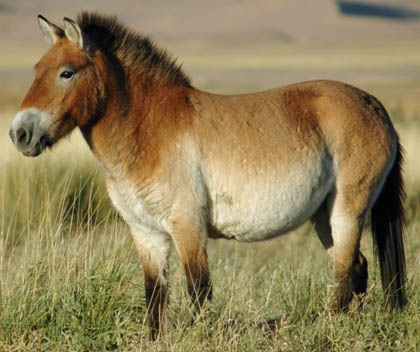
|
[Equine Species] Przewalski's horses (Equus ferus przewalskii), also known as Takhi, are an ancient population of horses native to the steppes of central Asia. They have been salvaged from the verge of extinction and reintroduced as a wild population. Przewalski for those challenged by the unusual combination of letters found in Slavic names is said Shuh-VAL-skee. Domesticated horses and Przewalski's horses can breed and produce a hybrid, even though Przewalski's horses have 66 chromosomes and domestic horses 64. There is a fair amount of controversy when the ancestral populations diverged. There are claims that the ancient domesticated horses used by the Botai Culture in Kazakhstan (about 3500 BCE) were from a Przewalski population. They are short and stocky with a basic dun color coat with colored areas called primitive markings.
.
-
Puissance
[Jumping] A puissance is a jumping competition in which the rail is raised higher on each round and riders eliminated each time a rail falls. The winner is the remaining rider.
-
Pull a Mane or Tail
[Grooming] Other than trimming with scissors, a mane or tail can be pulled. The groomer combs out some long hairs and raps them around a metal comb and then pulls until they come free. The progress takes time but in the end the horse has a natural looking shortened mane. For the most part horses tolerate this well unless you try to pull too much at a time.
-
Pulley Rein Stop
[Emergency Halt] With pulley rein stop the rider braces one hand on the horse's withers while pulling the other rein hard upwards and backwards in a series of pressure and release. That tends to get the animals attention, but is considered particularly harsh and used only as a last resort. The one rein stop is a similar measure, but executed differently, and is thought less harsh. The pulley rein is acknowledged as one of the five basic rein aids.
-
Purchase
[Equine Equipage] The purchase is the shorter arm of a curb bit shank that runs from the mouth piece to the cheek ring. The longer arm is called the lever arm.
-
Putting To (British Usage)
[Driving] Putting to is the act of attaching harness to a horse-drawn vehicle or load. In the U.S. this would be called harnessing.
Przewalski's Horse on a Russian Stamp
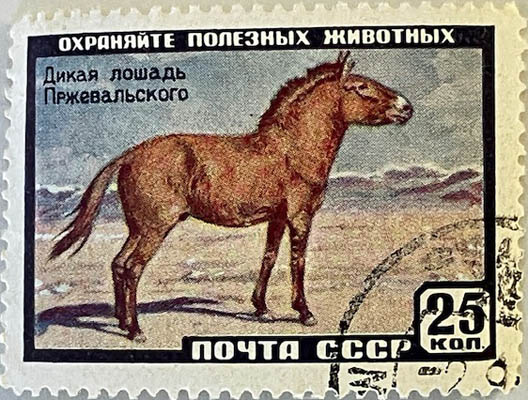
|
Glossary of Equestrian Terms: Main Alphabetical Listing
Links to Other Sites with Equestrian Interests
Back to Introduction









